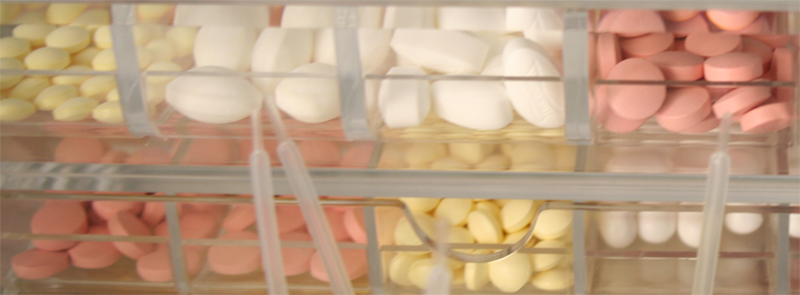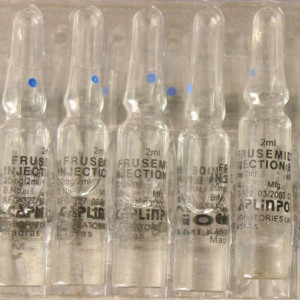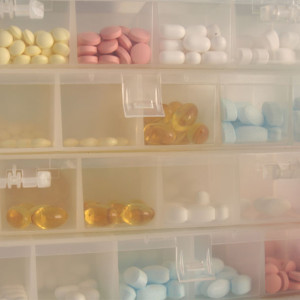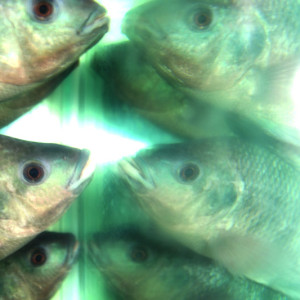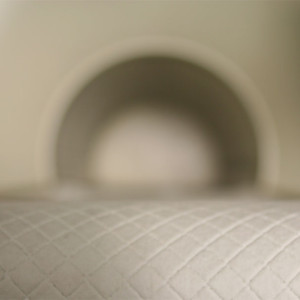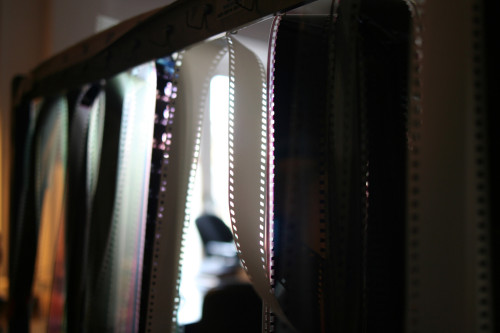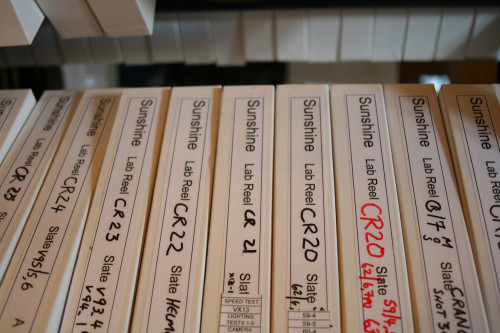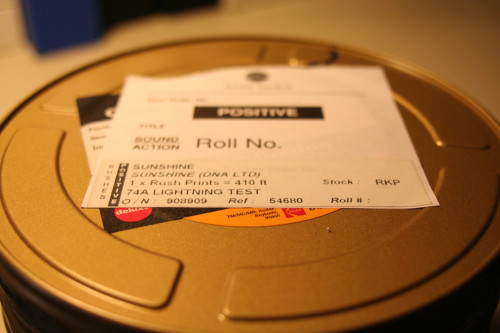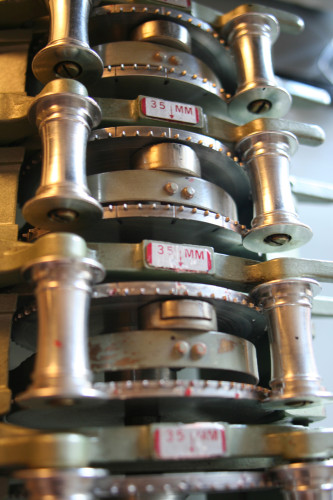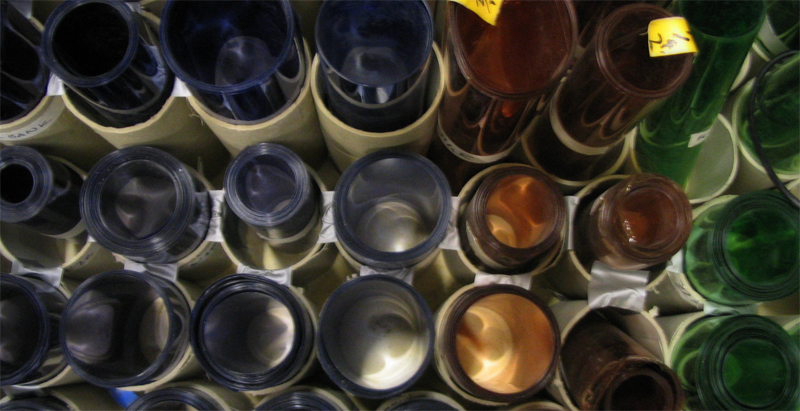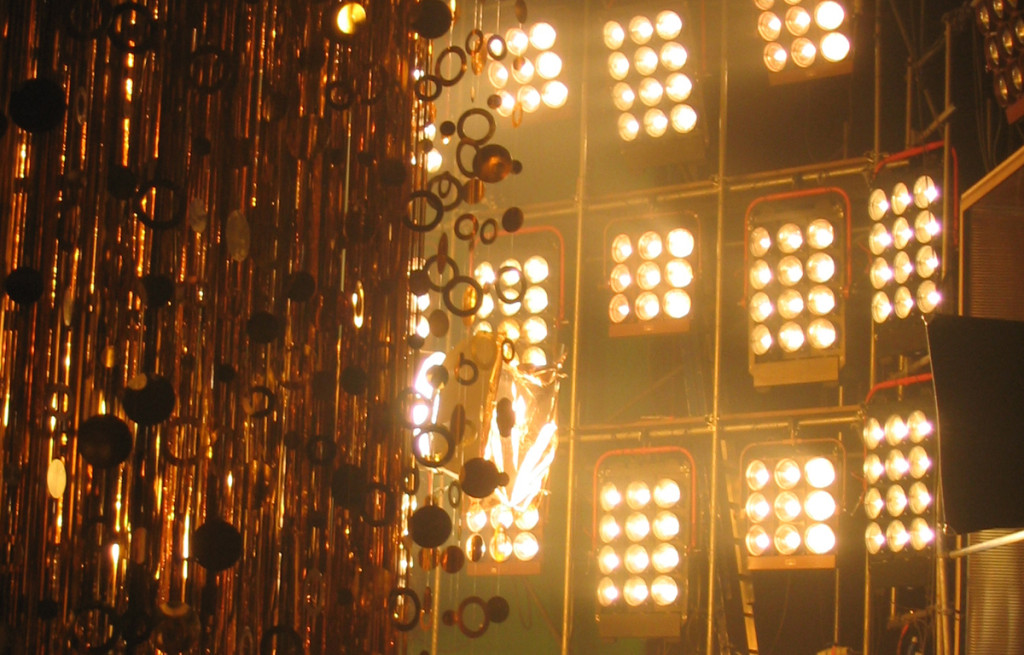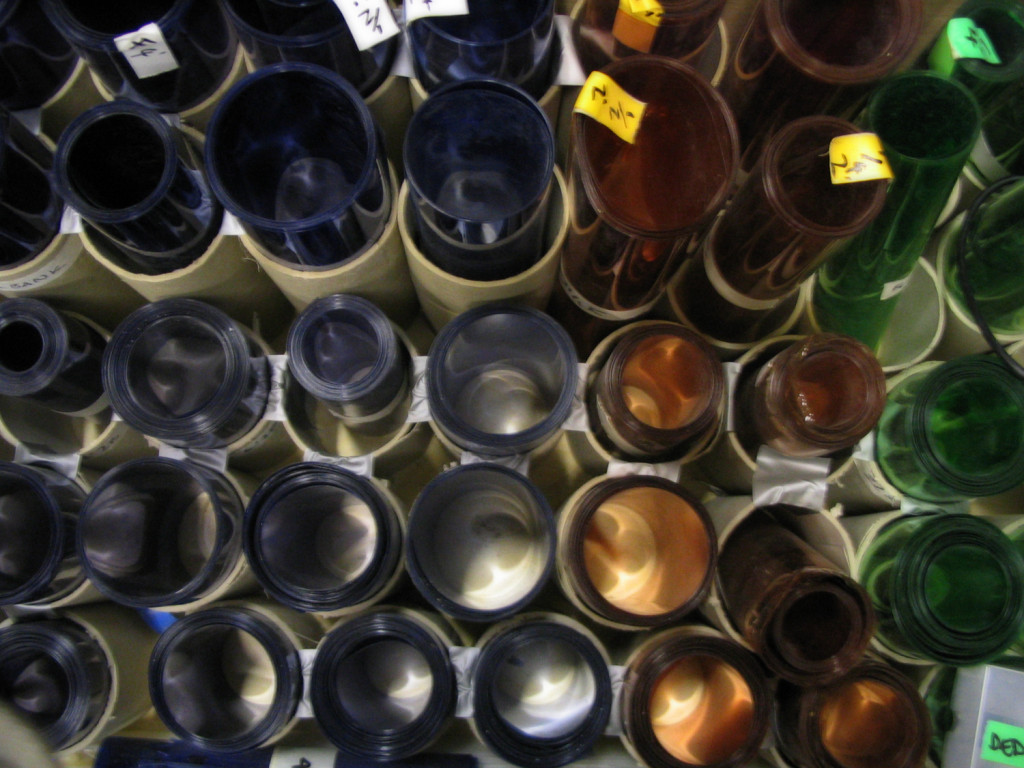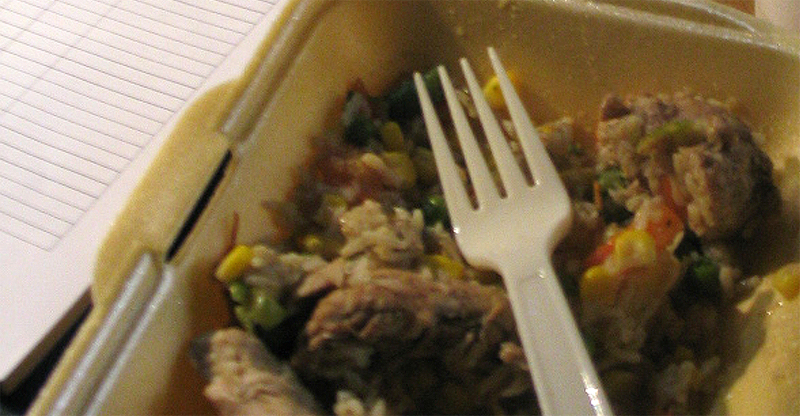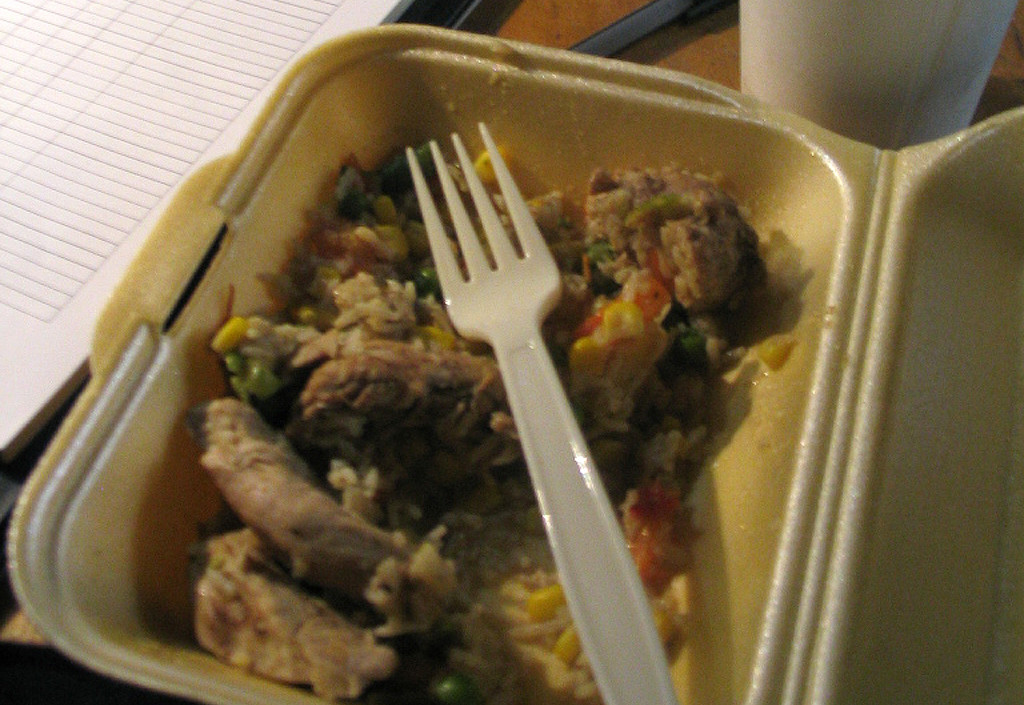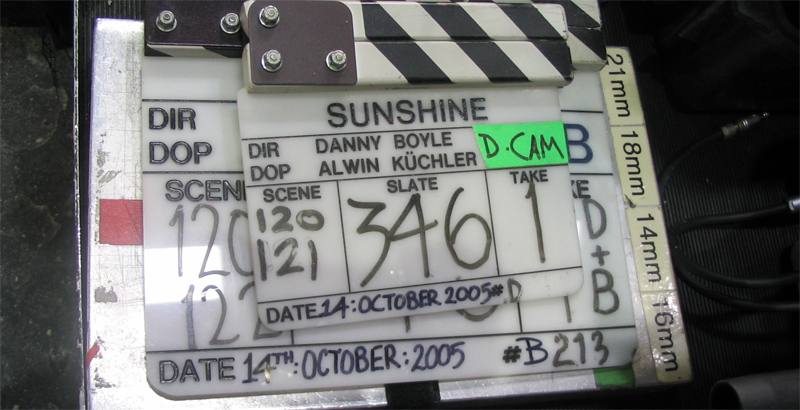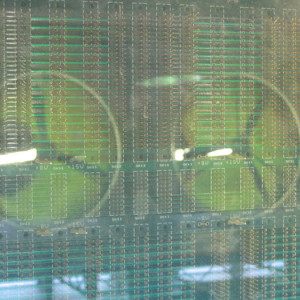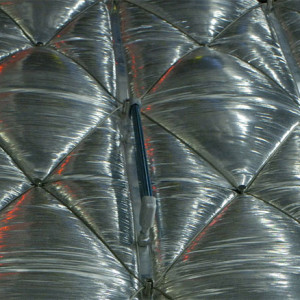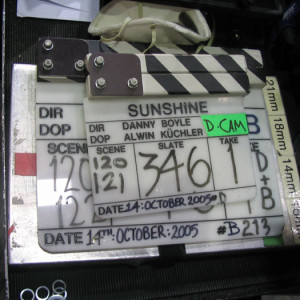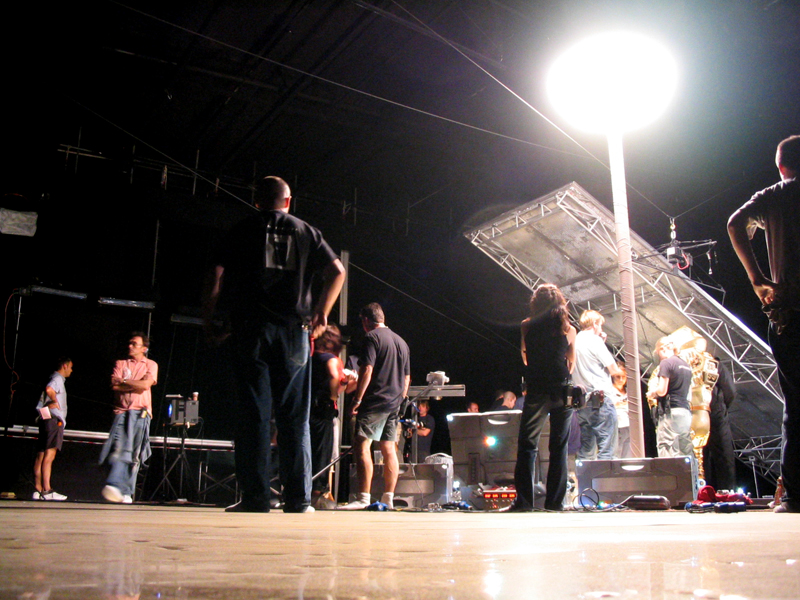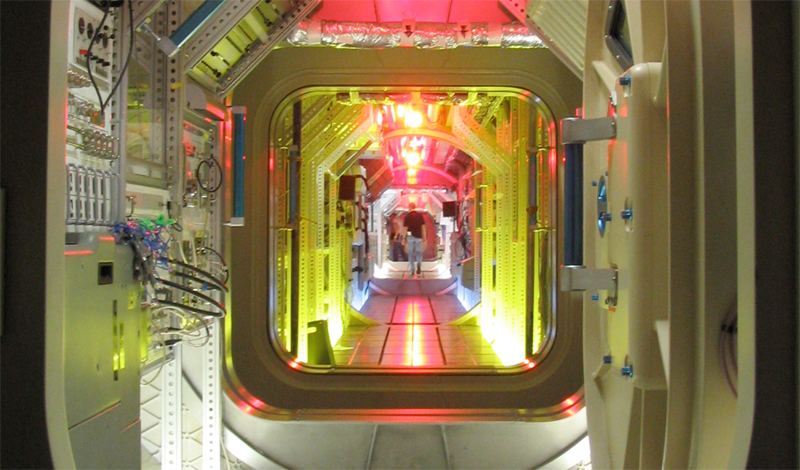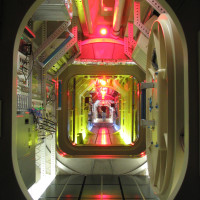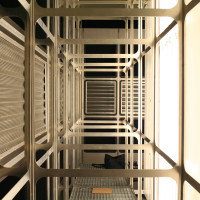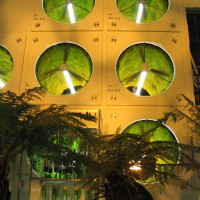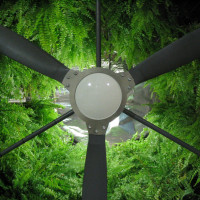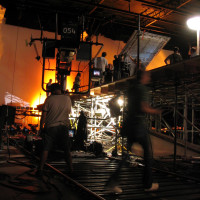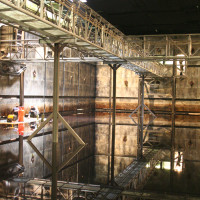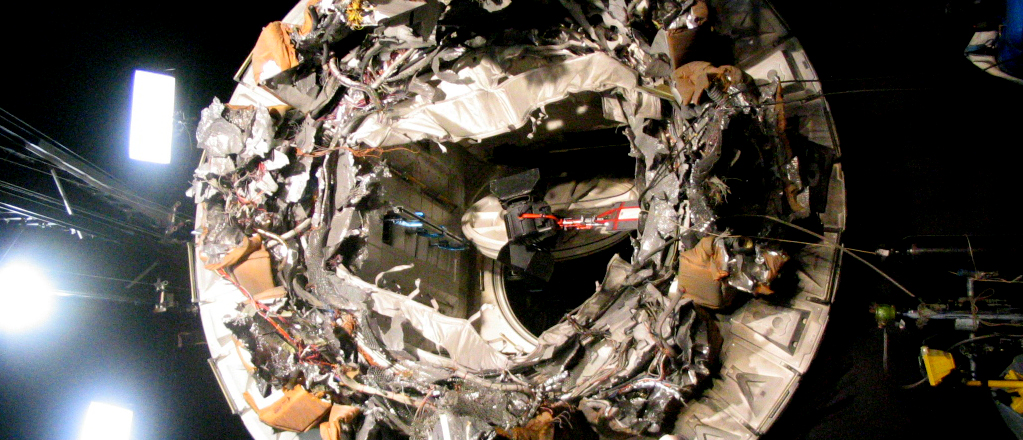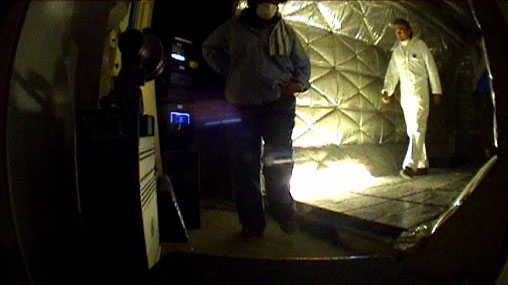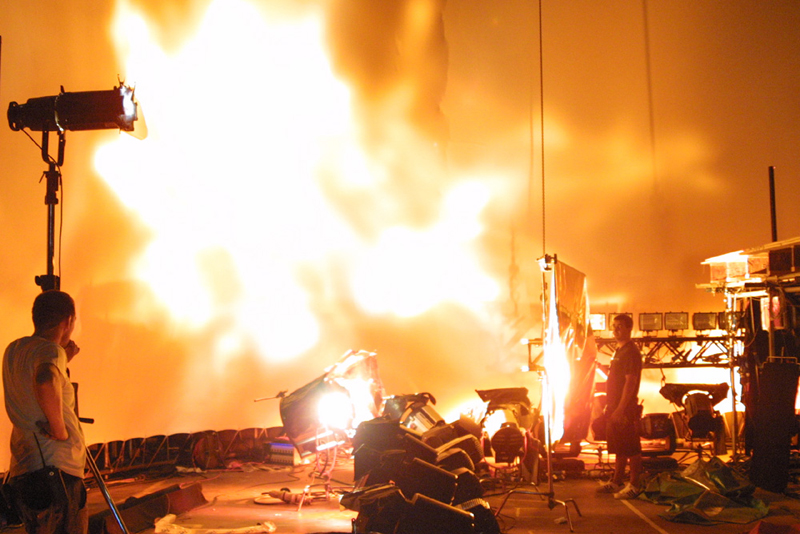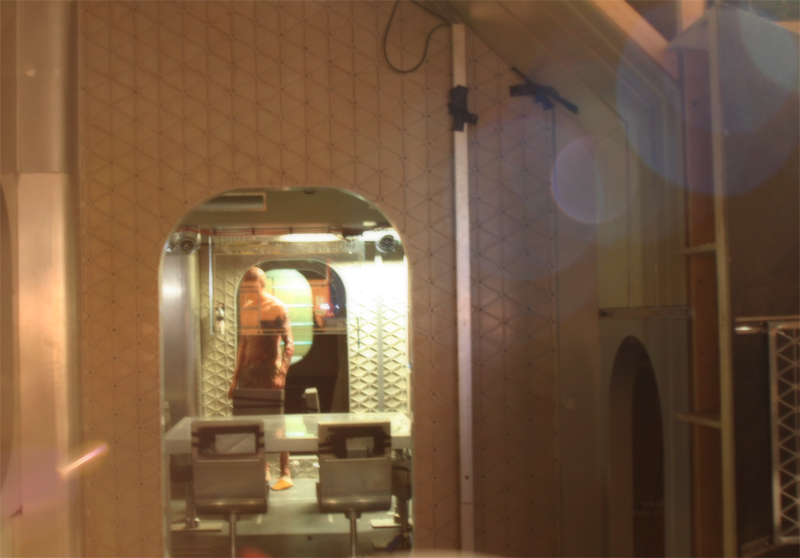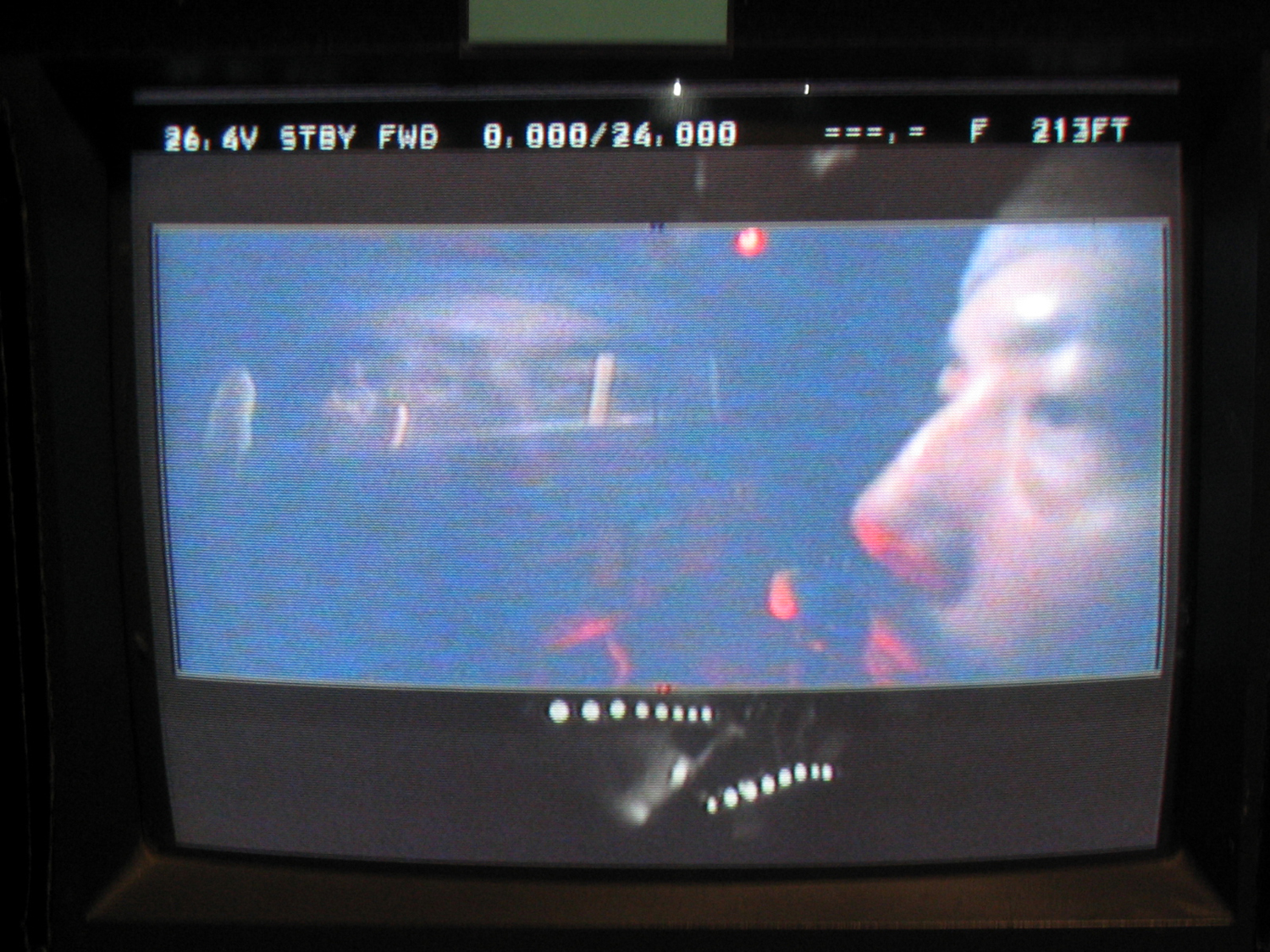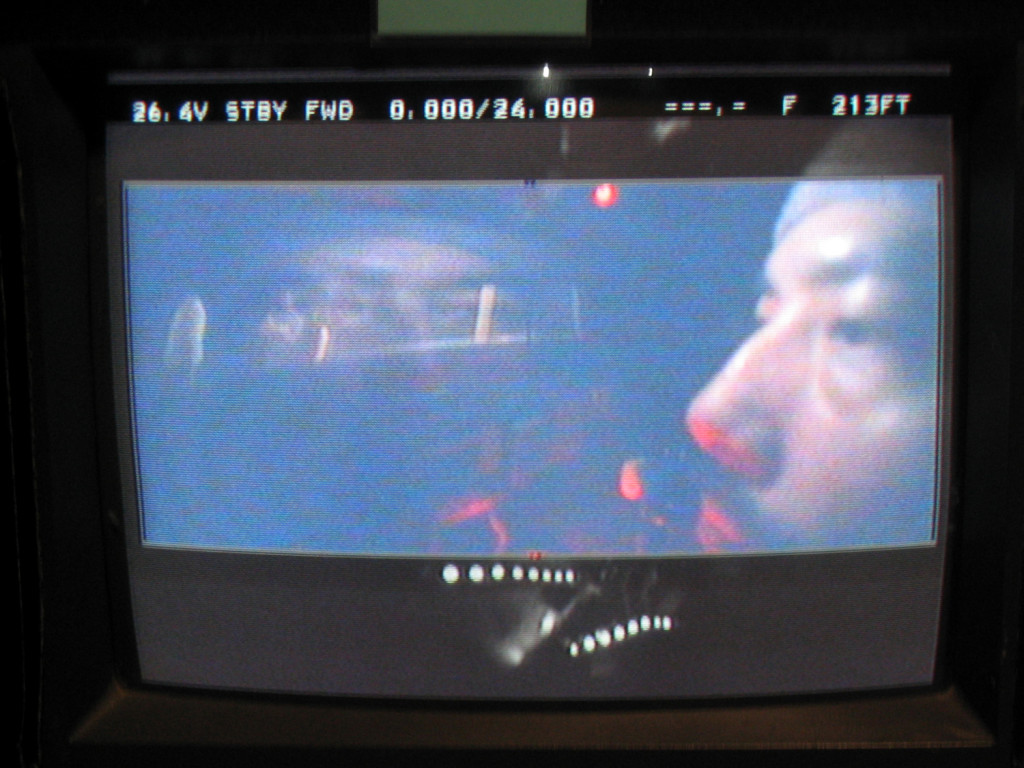Category Archives: Images
Telemetry
There’s a door right next to the entrance to Stage 5.
Wander in.
Take the stairs on your right and just stop a moment. Now, listen for the sounds… music, talking, shouting… screaming sometimes… You might hear the same sounds repeated over and over again. They might sound backwards to you. Don’t worry.
Follow the sounds up the stairs to the very top. The only way you can walk now is down the little hallway into the large, dark room. Really, don’t worry about the sounds.
Walk into the room. It smells of cloves. You’ve found the edit suite. This is where Editor Chris Gill and his team are based.
The sounds you’ve heard will more than likely have been from someone viewing the dailies/the rushes (delete as appropriate depending on whether you use American or British filmspeak). After the film comes back from the lab, the images and the recorded sound have to be synched up. That is what the clapper board is for- along with showing which scene and which take is being shot, when the clapper loader ‘claps’ the top down there is both a visual and an aural link which can be used by one of the Assistant Editors to get the pictures and sound in sync.
Chris is in editing every day and has edited quite a large number of scenes already. Early on in the shoot I asked him how he thought the film was coming together, he circumspectly answered that as long as things continued to go as well as they had been then he’d be very happy. I decided that Chris, more so than most people here, would have the best idea about the final outcome of the film as he is watching everything that’s been shot.
Now, when Chris is asked how things are going, he’s pleased to answer ‘very well indeed’ and is equally pleased to show off his work. I’ve seen quite a few scenes from the film already… and… well, Producer Andrew Macdonald thinks I’m too “gushing” when I talk about the film, but, I can’t help it, everything Chris has shown me is AMAZING!… But, for you, Andrew, I’ll try and be more measured. *ahem*
Everything Chris has shown me is rather good.
Andrew also teases me about being an Alwin Kuchler, Director of Photography, fangirl. I’m pleased to report that I was told today that the edit team are big Alwin fans as well.
Chris is already using music and sounds in his edits which is unusual this early on. I was very excited to find out this afternoon that he’s been using some sounds I sent to him in the rough cut of one of the scenes. About a month ago I made a CD for him of some recordings of the Aurora Borealis that were released on my friend’s record label a few years ago. This afternoon when I went for my regular visit to the edit suite, I heard the distinctive sounds of the Aurora Borealis coming from Chris’s room. He told me they fit perfectly and that Alwin loves the scene so much he’s going to ask Danny Boyle not to change it. Chris told me that he can’t imagine the sound department being able to recreate the Aurora Borealis sounds, so I gave him my friend’s email address so they could get permission to use them in the final film. :)
Another little sound tidbit for you space nerds: in another scene Chris is using the sound of Sputnik…
380 THz (3.8×10^14 hertz) to 750 THz (7.5×10^14 hertz)
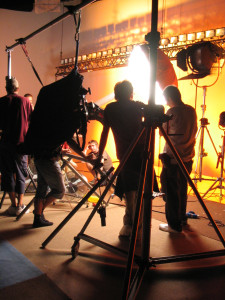 I’ve written a bit about how Alwin Kuchler, the Director of Photography, is playing with light in just about every shot. He’s had lights and lasers shining directly into the lens. There are lens flares, burn-out and distortion… He has filmed some of the most astonishing shots that look as if they’ve been through Visual Effects already yet he’s only used light…
I’ve written a bit about how Alwin Kuchler, the Director of Photography, is playing with light in just about every shot. He’s had lights and lasers shining directly into the lens. There are lens flares, burn-out and distortion… He has filmed some of the most astonishing shots that look as if they’ve been through Visual Effects already yet he’s only used light…
One only has to spend about 10 minutes on set before one hears the name ‘Reuben’ called out in a German accent. It’s Alwin calling Reuben Garrett, the Gaffer. Alwin always wants more light.
When I’m on set I often hang around Stephen ‘Math’ Mathie, the Lighting Desk Operator. The lighting desk has a nice big monitor so I can see what’s happening on camera… even if it’s Alwin lying on the floor with a light meter…
Today, I asked ‘Math’ how many lights he thought have been used on the film. As one would imagine on a film about a mission to the Sun, shot entirely indoors on eight different sets, there are going to be a lot of lights. He said that there were a few thousand:
1000 on Stage 5
200 on Stage 8
50 on Stage 11
150 on the Airlock
1000 on the Oxygen Garden
600 on the Flight Deck
2-300 on Stage A
He said this was a higher than usual number as instead of using ‘film lights’ they are using mainly practical lights. The sets are built with lights in them- in the ceilings, the walls and the floors- and those are used instead of big lights on stands… which is a good idea as there isn’t any room for them on the cramped sets anyway. This means that the lights are already set when they arrive and it’s then up to Reuben and Math to work out exactly what the lights need to do for each shot… And then, of course, for Alwin to ask for more…
Chicken and Rice
I’ve never worked on a film before. Apart from the thrills I get from seeing Danny Boyle in action, ‘discovering’ the remarkable Alwin Kuchler Effect, falling in love with Mark Tildelsey’s designs and chatting to the cast… if I’m completely honest, it can be really rather boring. There is a lot of standing around. Some days it’s taken literally hours to set up a shot… so hours and hours and hours of standing around…and waiting. Yes, the end result is amazing and beautiful and makes me go all gushy about Alwin, but, boy, it really can be boring.
I’ve just come back from the airlock set… I was waiting and waiting and waiting for a scene I’ve been waiting weeks to happen… I’ve seen the animatics for it, seen the stunt rehearsals, spoken to every single person involved in creating the shot and today is the big day when it’s finally going to be filmed.
I waited. And waited. And waited. Danny and Alwin were deep in discussion with Richard Conway, the Special Effects Supervisor. Then they had a rehearsal with the actors. More discussion. Another rehearsal. Discussion. Rehearsal. Discussion. Technical rehearsal. Discussion. More discussion. Then Troy Garity, Cliff Curtis, Chris Evans and Cillian Murphy were stood down while there were more discussions.
Cliff wandered off the set. He has a way of just…. disappearing… and no one ever sees him leave.
One minute Chris was there, the next… gone.
Cillian went back to his dressing room, probably to listen to music.
Troy stayed on set and started reading a magazine. He’s not been feeling particularly well for the past few days. He’s come down with the same illness I have, so I chatted to him for a while about fresh ginger and sweat lodges then we compared symptoms- he’s only just got over the headaches, my cough is worse than his.
More discussion on set.
I decided to go out and get some fresh air and a drink. I bumped into Alex Garland, had a chat and then wandered back in.
Nothing had been filmed.
I spoke to a couple of the people on production about the script, Alwin’s shots, Cillian and Hiroyuki Sanada (specifically: the changes from early drafts; how amazing Alwin’s shots are; how being able to stare at Cillian all day, isn’t such a bad job to have; how Hiro is missed by everyone). One of the Special Effects guys came up to me to get my email address because he wanted to send me some photos to put up here.
Still nothing was filmed.
They’re now eating dinner…
They’re running behind- three days? four?- and must complete four different shots by the end of today. They’ll finish very late tonight… and I won’t be here to see it.
Photos 6
Cast Photos
I really must reiterate that I am unable to just take photos of cast members and put them up on the website. All of them have photo approval within their contracts and as DNA Films are very kindly allowing me to do this blog, I have to follow those rules. Even the snaps I took yesterday of Hiroyuki Sanada having birthday cake with Cliff Curtis and producer Andrew Macdonald have to go through the approval process…
There are several reasons for ‘approval’. One) if the whole entire world was going to see a photo of you, wouldn’t you want to be able to say ‘yes’ or ‘no’ to it? Two) the publicity department need to make sure that I can actually use the photos – maybe a film magazine has bought one of the pictures of Chris Evans to use on the cover of their December issue and if I use it here right now, I’d mess the whole thing up. Three) there are loads of TV programmes that are going to do things on the film and, again, we have to make sure that someone hasn’t been promised ‘an exclusive’ that I’d completely mess up by posting a photo here.
I have, however, just spoken to Maya, my link to the distributers Fox Searchlight in LA, and told her that you guys really want some new photos of the cast members. So, don’t worry, we are working on it.
2014 Note: If there are any photos of cast members on posts earlier than this, they are a new addition and were not available on the original site.
How Do You Build A Spaceship?
First, you need to think about the purpose of the mission.
Go.
Then, you need to think about whether or not it will be launched from and land on Earth or from low Earth orbit.
Go.
Then, you need to think about whether it has passengers and/or payload.
Go.
Then, you need to think about living quarters, communications, electrical and computer systems, life support and how they are accessed.
Go.
Then, you need to think about how it can be easily built and maintained.
Go.
And if you are Mark Tildesley the Production Designer, before you are good to go, you’ve got to think of all of those things in several different ways.
First, in order to be believable, Mark has to think of designing a spaceship as if it was for the real world. The credibility of the film would crumble if the design of the ship was fundamentally wrong- for example, if the ship was a big cube and the characters talked about the smooth launch from Earth. Reading about and studying spaceflight and spaceship design, and talking to engineers, astronauts and scientists is vitally important. Mark’s office is full of books and images on space, spaceflight and spaceships. The walls are plastered with photographs of the International Space Station, inside and out. He immersed himself in ’space’. Most importantly, for this film, he has to think about the fact that it’s going to the awesome, boiling beast that is THE SUN.
Second, the film takes place in the future, 50-60 years in the future. Mark has to read up on technology and the future to get an idea of what, realistically, might be possible (let’s just say you aren’t going to see any replicators or tractor beams in the film). He also has to look back to the past to try and get an idea of just how much our world has changed over the past 60 years to see how much it might change in the next 60 years. For example, we still have cars that are “cars” rather than personal helicopters or hovervehicles, and though the design has been streamlined and the technology of the cars’ system has advanced, someone from 60 years ago would still recognise it as a car. Mark’s designs need to be recognisable, yet realistically, technically advanced.
Third, Mark needs to think about the aesthetics of the design- basically, it needs to look really cool. NASA engineers just have to make something functional and if they stumble upon an iconic design then so much the better (did you know that the external fuel tank on the Shuttle is orange not because it looks cool, but because to paint it white would add 500kg in weight?). Mark has to create a functional yet iconic spaceship, no questions asked. Otherwise what will they put on the T-shirts and coffee mugs?
Fourth, he has to think how this spaceship is going to be built in seven different buildings on a film studio lot. Unfortunately, there isn’t a studio here that is about one kilometre long so that the whole ship could be built as one big set. He also has to work out how much filming will be done on each set, how long it will be needed for each block of filming.
Fifth, he has to think about how it’s going to be used in the film. He needs to go over the script with a fine toothed comb and work out the layout of the ship, what the characters need to do in each space, how they get to each section, how many of the characters’ private cabins need to be built, how much ‘corridor’ needs to be built for each different set…
Sixth, he needs to think about how each set is going to be filmed – a tiny, little, enclosed room with no space for more than one person might not be ideal for a film crew. He also needs to think about special effects and CGI. How are they going to make the actors ‘float’ on this set? How are they going to “extend” that set so it looks like it’s a mile wide? Is every bit of the set going to be filmed or can just a small section of it be built?
Seventh, he needs to think about how it’s actually going to be manufactured. There isn’t a big shop called ‘Movie Spaceships Galore’ that he can just walk into to get everything he needs. Every panel, every rail, every floor surface, every nut and bolt needs to be sourced or manufactured. And that’s just the shell of the set.
Eighth, he needs to think about how it’s going to be built. Does every set need to be finished at the same time? Is there any way that one stage can be used for more than one set? How many people will it take to build this (over 200, as it happens)? Will it be finished on time?!
Ninth, he needs to think about the smaller stuff – how it’s going to be lit, where the lights will be placed, what props are needed and where. There are the monitors, the switches, the sockets, the cables which make it start to look like a working spaceship. Then there is everything from pieces of paper with formulas scribbled on them, to the kitchen, to cupboards filled with medical equipment, to all of the idiosyncratic ’stuff’ that makes one character’s bedroom different from another’s.
Tenth, he needs to think about the outside of the spaceship. How does it move? Where are the thrusters? Where is that thing mentioned on page 98?
Along with all of that he’s also got to think about how much it’s all going to cost (a massive amount, right, Andrew?!) and how to get it all done within the budget.
The whole process, from beginning to end, is entirely collaborative. He oversees and liaises with several different departments, all in charge of various different parts of the spaceship- the Art Department, Set Dressers, Props, Miniatures, Special Effects, Visual Effects… and I often see him in Accounts. For more than a year before filming started Mark has been working directly with both Danny and Alex to create a believable, functional, iconic spaceship.
It’s actually so iconic that all I can show you are these little bits…
Gonna Shine Like A Sunbeam
They’ve been filming in Stage A for the past several days. A lot of really important scenes happen there throughout the film and for the past couple days the set has been covered in filth. The other day the set was pretty bad, today, however, everyone is wearing either dust masks, protective clothing or both. The air is hazy. Everyone is covered in dust and dirt. It’s not helping those of us who have caught the nasty cold going round.
I went to the set to find Suttirat Anne Larlarb to have a chat about the costumes and as I got to the top of the stairs, Danny was walking up the corridor wearing a protective suit. He looked so cool I had to grab a snap.
My first thought was the Beastie Boys’ Intergalactic video…
Incandescent
Even though the set is closed to the likes of me this week, I got a chance to talk to one of the actors last night to find out how everything was going. He said:
It’s hot.
Take that literally and/or figuratively.
2014 Note: In this post I was referring to Mark Strong. I wasn’t permitted to mention his name nor his character’s name nor did Danny allow me on set when Mark was filming. I did break that rule one time and snuck this photo of him though.
Lord of Darkness
I might go on about Danny’s brilliance as a director and, yea, sure, I probably fawn over Alex and his brain a lot, but do you want to know who blows my mind? Alwin Kuchler the Director of Photography (DOP).
There are a very few films I’ve seen where I am awed by or even notice the DOP’s work. Every shot Alwin does, however, is a piece of art. I’ve been on set when after Danny calls ‘cut’ there is this murmur that spreads ‘how does he do that?!’ ‘that was remarkable!’ ‘Alwin is amazing’. Sometimes after watching a shot on the monitor I’ve actually been left speechless.
Apparently, the company who process the film got in contact to say there was a problem- the shot was all blurry and burnt-out or something – and were taken aback when they were told ‘no, there’s no problem, that’s how it’s supposed to look.’
There isn’t a single shot I’ve seen that can be called ‘normal’. He’s using and playing with light in such a way that it distorts the shots. He’s shining lights and lasers directly into the lens. He’s shooting through warped glass. He’s using reflective materials and shining extremely bright lights into it. There are flares and burn-out and over-saturated colours. Yet still… it’s dark…
Alwin Kuchler, the Lord of Darkness.

